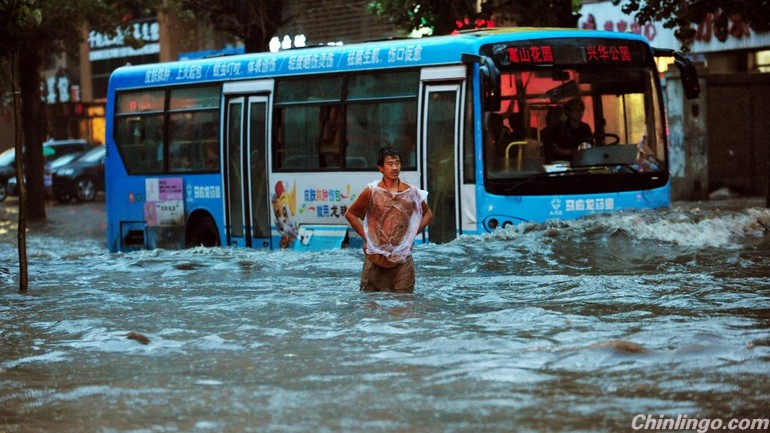
ON THE evening of August 7th, just as Friday rush hour began, a brief storm drenched parts of Beijing. The rainfall of three hours submerged many roads under water and paralysed traffic. Pictures of soggy commuters trudging through knee-deep water were soon posted on social media. Beijing, China’s landlocked and generally dusty capital, "now has sea views," a typical mircoblogger remarked sardonically.
8月7日傍晚,就在周五晚高峰刚开始时,一场短暂的暴雨席卷北京部分地区。三小时降雨淹没了多条道路,令交通陷入瘫痪。社交媒体上,很快出现了一些浑身湿透的通勤者在齐膝深的水中艰难行走的照片。一名微博用户讽刺道,北京,这个位于内陆、通常尘土飞扬的中国首都,"现在有了海景"。
Urban Chinese are becoming all too familiar with such episodes. The number of Chinese cities affected by floods has more than doubled since 2008, while over the same period the country's major rivers have mostly remained stable. In 2013 more than 200 cities were swamped at some point. Why are so many Chinese cities flooded?
中国的城市居民正越来越熟悉此类插曲。2008年以来,受洪水影响的中国城市的数量翻了一番还不止,然而与此同期,该国各条大河多半保持稳定状态。2013年,有200多个城市曾经被淹。为何有这么多中国城市水漫金山?
The short answer is that the country’s urban sprawl has been expanding much faster than its drainage infrastructure could catch up. The government began to recognise the problem of flooding in the late 1990s, after a massive flood along the Yangzi river killed thousands of people. But the policymakers in Beijing regarded it largely as a rural problem. They poured money into the building of massive dams, whereas urban drainage was by and large neglected.
简而言之,该国城市扩张速度过快,排水基础设施跟不上。20世纪90年代末,在长江流域一场大洪水后,政府开始意识到洪水这一问题。但是,北京的决策者在很大程度上视之为一个农村问题。他们投入大量资金建设大坝,而城市排水系统则在总体上受到了忽视。
According to Zhou Yuwen, a professor of civil engineering at the Beijing University of Technology, most drains cannot cope with the sort of rainfalls that has a 100% chance of occurring in any given year. In other words, it is all but certain they will be overwhelmed by ordinary rains—every year.
北京工业大学市政工程学教授周玉文说,大多数排水设施都不能应付每年都百分之一百会出现的降雨强度。换句话说,它们肯定会被普通降雨压垮——每年都会。
To make matters worse, Chinese cities have expanded rapidly, some directly into flood plains. Rivers and lakes were reclaimed to make way for development. The amount of urban land in China has more than doubled since 1998, reaching a total of 50,000 square km by the end of last year, and almost all of it is covered with concrete and asphalt.
雪上加霜的是,中国城市快速扩张,其中一些城市直接扩张进入泛滥平原。填河填湖,为开发让道。1998年以来,中国城市面积已经翻了一番还不止,于去年底达到5万平方公里,而且覆盖城市地表的,几乎全是混凝土和沥青。
All this is exacerbated by China’s often impetuous approach to urban planning. When the planners in charge of Beijing designed its roads a few decades ago, for example, sunken underpasses were chosen over elevated interchanges for the reason that they seemed more appealing visually, as well as being cheaper to build. They have also, as it turns out, become a particular source of sodden misery.
令所有这些问题更严重的是,中国对待城市规划的态度往往急躁而冲动。例如,数十年前负责北京道路设计的决策者选择了下沉式立交桥而不是高架式立交桥,理由是下沉式立交桥在视觉上较美观,同时建设成本较低。结果却是,这些下沉式立交桥成了城市内涝的一个原因。
Beijing has 149 such underpasses in its urban districts. With inadequate drains and pumps, even a single heavy rain can turn them into swimming pools, bringing traffic to a halt in the process.
北京城区有149座下沉式立交桥。在排水管道和水泵不足的情况下,单单一场大雨就能使之成为游泳池,令交通陷入停滞。
The problem of urban flooding is not unique to China, but the country’s rapid urbanisation has made the damage exponentially greater. With climate change on the horizon, many of its cities will have an especially hard time coping with the increased frequency of extreme weather events.
城市内涝这一问题并非中国所独有,但该国的迅速城市化令损失呈几何级数增加。气候变化已初露端倪,中国很多城市将艰难应对极端天气事件发生频率的增加。
A global study of flood losses, published in Nature Climate Change in 2013, ranked the southern metropolis of Guangzhou as the most vulnerable of the world's 136 major coastal cities, measured in terms of potential damage. Without forward-looking measures, by 2050 the city could be devastated to the tune of $13.2 billion in a single year.
2013年发表在《自然》杂志上的一篇研究全球洪灾损失的论文认为,在全世界136个沿海大城市中,就可能遭受的损失而言,中国南方大城市广州是最脆弱的。若不采取前瞻性措施,这个城市可能在一年内就遭受多达132亿美元的损失。
This is all the more frustrating, or paradoxical even, because China's cities are also in desperate need of water. More than 400 of its biggest 600 cities face routine shortages.
情况非常令人沮丧,或者说甚至有些自相矛盾,因为中国城市同时极度缺水。在中国最大的600个城市中,400多个城市供水不足。



 闽公网安备 35020302035673号
闽公网安备 35020302035673号
0 responses on "Insufficient drainage capacity causes urban flooding in China"